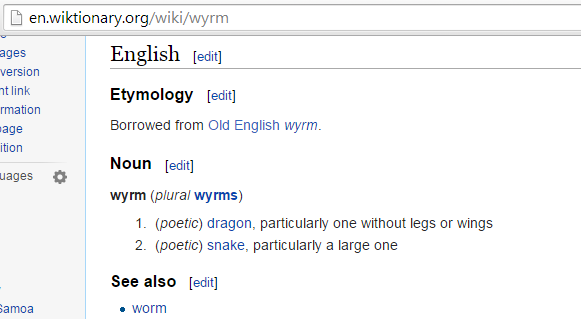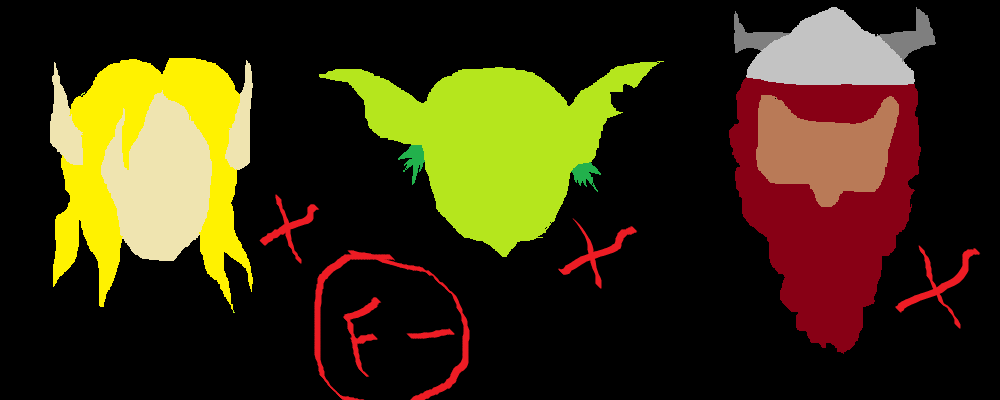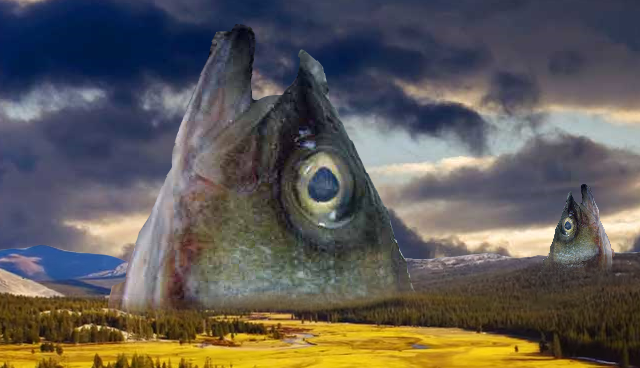
Featured Blog | This community-written post highlights the best of what the game industry has to offer. Read more like it on the Game Developer Blogs or learn how to Submit Your Own Blog Post
I Like Tolkien Too, but Please, No More Fan Fiction
It seems as if most modern fantasy games are Tolkien fan fiction. If not, they’re at least based off the same overused sources. There are vastly interesting settings to use. Let's break that mold.

One Man’s Dragon is Another Man’s Wyrm
 “No no no, that thing in The Desolation of Smaug isn’t a dragon; it’s a wyrm.”
“No no no, that thing in The Desolation of Smaug isn’t a dragon; it’s a wyrm.”
“It’s a dragon; all the dwarfs call it a dragon.”
“It’s not a dragon, you see. Dragons have four limbs, that thing only has two.”
“It has front wings and two legs in the back. It has four limbs.”
“I mean four legs. It has wings sure, but it has to have four legs to be a dragon. It’s a wyrm.”
I sat on a balcony eating lunch as the game developers at a table to my left debated passionately about the status of Smaug. The man to my right, also watching, turned to me: “This is interesting.” He took a sip of his soda. “I really like fantasy.”
I enjoy fantasy fiction as well, but this conversation felt off. It irked me in some strange way I struggled to find words for, and still have some difficultly vocalizing. I think part of it may be the triviality of the conversation; how insignificant it felt to be discussing the word used to describe Smaug, a fictional character in a movie adaptation of a book. Whatever we call Smaug, it doesn’t affect the character’s role within the film, nor will it change what the dwarves call it. Yet, that approach feels dismissive.
I’ve been in debates about the worst film in the world (I think it’s The Room, others think it’s Trolls 2), which is just as trivial and meaningless and ultimately won’t change either film. So there has to be something else.
I think what bugged me about the conversation is that it was nitpicking details when fantasy, especially in videogames, has a much larger problem; how we can’t seem to escape these inbred Tolkien dreams. You see, most modern videogames rely on the same general fantasy tropes and relations. They use things like elves and dwarfs and dragons and trolls. They have humans with kingdoms and the humans usually have greed and power issues. Elves live in the forest and dwarves have mines. Oh, goblins too. Goblins are around; usually in camps.
“But it works” someone might tell me (and has, in the past). “It’s a good model with interesting relationships; people understand this fantasy world without exposition or explanation. And stop calling it fan fiction.”
What is Fan Fiction?

That’s a tricky question. I’ve seen lists that categorize types of fan fiction, but I’ve struggled to find a single stable definition for the term itself. Regardless, I used to hate fan fiction. Well, hate is a strong word. I used to strongly dislike fan fiction. The way I justified my dislike of it was through the definition:
Fan fiction is a form of storytelling where the creator lacks a base level of creativity and makes up for it by appropriating and misusing characters and setting created by others. It is always better to come up with original material than write fan fiction.
I held onto this definition for a long time. It allowed me to dismiss all fan fiction I came across as garbage and generally ignore it. Then, in late 2011, several of my friends came out as Bronies, fans of the children’s TV show My Little Pony: Friendship is Magic. They wrote fan fiction and did fan drawings. We got into debates about fan fiction. With no decent solid definitions online or in dictionaries to support either of our claims, we had to talk it out.
Q: Why would you write My Little Pony stories?
A: Because we love the show and wanted to give back in some capacity.
Q: So it isn’t about stealing or ruining content?
A: Not at all, it’s about expressing our support of the show in a constructive media creating way; adding to the pool of MLP stories, helping grow the community.
Q: But do you use characters from the actual show in your stories?
A: Sometimes. Everyone thinks about characters from media already: what would Sherlock Holmes do if he was to encounter this? How would Super Man address that problem? The main difference is that we write these thoughts down to make them more permanent.
I understood it a bit more. My friends weren’t uncreative people either. I knew they had the ability to craft their own characters and settings, so I had to alter my definition:
Fan fiction is a form of storytelling where the creator alters elements of another’s work to explore how characters would react and how situations could play out. It could be a good exercise in writing, but you can’t make money from it, so it’s generally better to just write your own original material.
Yet, my definition was still lacking. How would I account for Mary Sue characters? Characters that carry out wish-fulfilment for the author (or audience), or characters that literally are the author inserting themselves into the fiction. Well, Twilight is very much a Mary Sue playing on modern supernatural elements: vampires and werewolves. It also did extremely well. This book series split my definition wide open. It is a Mary Sue, and Mary Sue stories are a type of fan fiction. But what is it fan fiction of? General folk lore? Romance novels? Isn’t this a bad series with poor writing? Or am I missing something?
What Isn’t Fan Fiction?
 At this point, the only real defining element I could pin down about fan fiction is that it couldn’t be sanctioned by the original author, and therefore, cannot make money: So if I was to write a fan fiction of Twilight, that is what it would remain. A fan fiction of Twilight.
At this point, the only real defining element I could pin down about fan fiction is that it couldn’t be sanctioned by the original author, and therefore, cannot make money: So if I was to write a fan fiction of Twilight, that is what it would remain. A fan fiction of Twilight.
But even that concept doesn’t fit, 50 Shades of Grey began its life as a fan fiction of Twilight, originally named Master of the Universe, featured Bella and Edward, and was released as an episodic web series. After renaming the characters and the title, it was sold as a book. Stephanie Meyer has been quoted on the topic saying “I’ve heard about it; I haven’t really gotten into it that much. Good on her—she’s doing well. That’s great!”
Even bad Mary Sue fan fiction has its place. Have you ever read My Immortal? It’s a Mary Sue of Harry Potter, considered one of the most infamous fan fictions out there. I read the whole thing once as an endurance test. It’s atrocious, but enjoyably so. Almost like a masochistic fun.
After all of this, my new definition of fan fiction is as follows:
Fan fiction is a thing that some people do; it usually involves being inspired by another’s work. Some fan fiction is good. Some is bad.
That’s about as in depth as I can go right now with my definition. Fan fiction became such a blanket term: how some fan fiction became so successful, how creative people can write it, how it’s hard to tell if a work is a fan fiction or if it just draws on the lore of another work. Is Tolkien just fan fiction of Anglo-Saxon and Norse mythology?
Also, as polarizing as both the Twilight and 50 Shades series are, they both have film adaptation deals, sold an obscene number of copies, and did something unique: They began life as fan fiction, and then altered the content into something distinctive. They were powerful enough to reshape their captured worlds. Because of Twilight, we will never be able to think of vampires without sparkling or rippling abs. Even if we only joke about sparkling vampires, Stephanie Meyer forever changed our modern interpretation of vampires. And 50 Shades of Grey took that series, Mary Sue’d the Mary Sue and is now a completely separate series. That’s pretty cool.
This is also what Tolkien did to the mythology he drew from. He took lore, reshaped it, and he made them his own. This is the part that most Tolkien fan fiction can’t do: brand their components as unique and separate. Sure you may know of some fantasy games with interesting memorable names, but an elf is an elf is an elf. None have done to elf to separate it from Tolkien as much as Twilight did to vampire, and as 50 Shades of Grey did to Twilight.
Think Outside of the Accepted Tolkien Dream
 Very seldom have I encountered a fantasy videogame that hasn’t relied heavily on Tolkien lore. This applies to novels to a degree as well, as both Harry Potter and Game of Thrones rely on the same understanding of magic and dragons (and other various sparse elements) for their worlds that Tolkien made popular. Yet, I’m not well versed enough in fantasy novels to make more of a claim than that.
Very seldom have I encountered a fantasy videogame that hasn’t relied heavily on Tolkien lore. This applies to novels to a degree as well, as both Harry Potter and Game of Thrones rely on the same understanding of magic and dragons (and other various sparse elements) for their worlds that Tolkien made popular. Yet, I’m not well versed enough in fantasy novels to make more of a claim than that.
About once a month, I go to a bar with a developer friend and we shoot the breeze; usually we drift from topic to topic as the conversation naturally evolves, promising each other that we’ll wrap up stories we began minutes before, but never come back to, as the discussion evolves. Yet, when we met last, the conversation remained on the topic of Tolkien lore for a while, as he played devil’s advocate to my critique of modern fantasy.
“Tolkien’s worlds are based on real mythology,” he told me.
“Yes, but he’s the one that paired elves with woods, dwarves with mines.”
“If you look into Norse mythology, dwarves have always had a relationship with forging. A lot of Tolkien’s settings have roots in actual mythology,” he explained.
“Really? I’m pretty sure Tolkien even made up that bit. I know they existed before, but he did a lot to flesh out those creatures.”
“They did a lot of forging, trust me.”
He was right about the forging. Dwarves did forge in Norse mythology. They didn’t live in mines though. As such, Tolkien didn’t make up the terms dwarf or elf either. He selected these beings from the ever-expanding roster of mythical creatures. Yet, he is the one of the first (if not the first) to pair all of these mythos up in that particular dichotomy, attributing those personality types and relationships to them. And he did it damn well. So well, that Tolkien fan fiction is the staple of modern fantasy.
This isn’t a good thing; it’s a good thing for the Tolkien family and estate, but not for the rest of us creators. No one should be comparing or debating the merits of using wyrm over dragon (sorry dragon scholars). The reality is: there is no difference. At least none as far as real world folk-lore is concerned. They’re simply different terms originating from different languages for the same mythical creature. Instead of talking about what makes a dragon, we should be debating the merits of keeping dragons, and all of this expected lore, over discarding them.
For instance, if you’re making a fantasy universe, why do you need elves? You should be able to explain why the inclusion of elves within your universe aids your story in a meaningful way. Claiming that you need elves to make a fantasy world isn’t a valid answer. That’s just buying into the Tolkien dream. So if not elves, dwarfs, orcs, goblins, and dragons, what else is there?
Don’t Try to Be Tolkien; Try to Be like Tolkien
 Rather than copy the creatures and world that Tolkien made in his series, follow his footsteps and create rich worlds the way he did it; your world might not look a lot like that of The Hobbit, but it will be as rich and deep, with histories and lore that you fully understand, rather than those established by him that you just grasp.
Rather than copy the creatures and world that Tolkien made in his series, follow his footsteps and create rich worlds the way he did it; your world might not look a lot like that of The Hobbit, but it will be as rich and deep, with histories and lore that you fully understand, rather than those established by him that you just grasp.
LotR is based on real world mythology, reshaped to fit the structure and world of the novels; the same sources used for LotR can be used for your world building. If you really want to use dwarves in your game, research their roots. There is a deep and rich history of dwarves before Tolkien ever got to them. I had a lengthy discussion with a medieval scholar on dwarves once.
“Early Christians believed that dwarves spontaneously generated from the Earth, much as how they believed plants would grow. You see, they had no understanding of pollen and microscopic life, so they thought that fungus and plants would just grow from nothing: spontaneous generation.”
Now that would be neat. Dwarves that look like trees; bark for skin, spawning from pods on the ground. Who says dwarves need mines? It would be rebranding them like how Stephany Myer rebranded vampires. More so, do I even need to call them dwarves?
According to the Bible, angels have more than one set of wings depending on their rank. According to the Bible, Satan has multiple faces as well. Revelation 4:8 talks about angels covered with eyes; literally covered with eyes. Why don’t we have more games with angels that look like that? Why don’t we replace elves with these creatures?
When I tried to learn Latin, I read a story (in a beginner’s Latin book) that talked about a night watchman coming across a man wearing stone armor. When apprehended, the man turned into a wolf and ran away. Apparently werewolves wore stone armor; that was their tell for being a werewolf. That’s a really cool concept.
Truth be told, I never could verify the werewolves wearing stone armor mythology. Same for the dwarf spontaneous generation. But it doesn’t really matter. Regardless of if the mythology is true or not, I now have unique concepts for fantasy creatures.
Use Wikipedia: It’s Ok, You’re Writing Lies Anyways

When it comes down to it, don’t be ashamed to use Wikipedia or any poorly document sources for your fantasy universe research. Wikipedia has been wrong in the past about various topics, but does that really matter when you’re trying to create a fictional world; when you’re writing lies? Unless you need to retain historical context or accuracy for your work, Wikipedia is fine for concepts. Just don’t go quoting it to friends. Writing fiction is fine because everyone knows it’s lies; you’re just using Wiki as a primer to turn some imagination gears. Pitching it as facts may lead to issues.
If researching online, be sure to: browse forums, religious sites (I find Early Christianity, Scientology, and Buddhism to be wonderful for inspiration), and cultural sites; places that don’t directly address modern fantasy. If you’re up for it, go to local libraries and read pre-Tolkien fantasy books, or global Renaissance and medieval texts.
Of course all this takes time. Why research when you could just rely on old tropes and creatures to populate your world? There are a lot of advantages of just sticking to the accepted fantasy settings: using creatures that have been established, so the audience knows what they’re getting. There’s no need to shape the way different sentient beings interact with each other as it is cannon as well. All the creative team really has to do is come up with the actual characters and tweak it a bit. It’s a pretty stable mold to start from.
There’s nothing really stopping anyone from making more Tolkien fan fiction, and the lore is pretty much readymade. It’s just not particularly clever or interesting. When fantasy games are meant to be escape from reality, how far can you really escape and discover when you can guess the lore and story already?
The Advantages of Creating Your Own Fantasy
 I once took a Unity programming class. About half way through the course, the instructor announced that we would be splitting into self-selected teams for the final project, and that we would be allowed to define the scope and scale of our games. The two people sitting behind me were fairly close. They had expressed a shared interest in Magic the Gathering within the first hour of the course and often played a game or two before the class each day. Once the instructor mentioned the final project, their conversation went something like:
I once took a Unity programming class. About half way through the course, the instructor announced that we would be splitting into self-selected teams for the final project, and that we would be allowed to define the scope and scale of our games. The two people sitting behind me were fairly close. They had expressed a shared interest in Magic the Gathering within the first hour of the course and often played a game or two before the class each day. Once the instructor mentioned the final project, their conversation went something like:
“What kind of game do we want to make?”
“I was thinking an RPG?”
“Cool. Fantasy or sci-fi?”
“Fantasy.”
“Nice. Can I be an elf?”
“Yeah, though I’d want to tank as a dwarf.”
“Cool. We should include dragons and wyrms to ride on.”
As soon as the allotted class time was up, I darted from the classroom. I wanted no part of that game. If AAA companies are spending millions of dollars on Tolkien clones with mixed rating and sales, I don’t want to compete with that market. There are better ways to allocate your time. Simpler ways too.
For instance, if you don’t have the team or the time to make elves and dwarves and all those other things; why not consolidate. Is having a multitude of sentient beings really critical to your game’s core? Are you exploring territory with that dichotomy that hasn’t already been covered?
If you’re bad at writing dialogue or can’t voice act well (most of us can’t voice act well, don’t worry), why fake that accent or try to write that way? Make up a new dialect and language. You only have so long on this Earth, is learning Tolkien Elvish that important to you?
What’s more impressive: A game that over-scoped because the creators couldn’t fit in all the expected fantasy elements they wanted, or a game that is short and small but showcases two unique creatures in a vastly different setting?
Maybe this is too much to ask. Perhaps you’ve spent years working on your Tolkien populated world. If you have a fantasy universe that you’re really attached to, sit on it for a while. Slowly think about why you include all the popular fantasy elements one by one, and try to reshape them, or at least consider why you chose to include them.
Keep in mind, Bioshock wasn’t always a dystopian underwater game. Originally, it revolved around Nazi genetic experiments in a desert island secret lab. Nazis were popular bad guys. They’re still popular bad guys in the USA. Yet Irrational Games chose to go an alternative route. Bioshock still makes top 10 videogame lists to this day. Even better, they created their own cannon. Splicer is a word now and drums up its own imagery.
You say Splicer, I say Bioshock.
You say elf and I say Tolkien? Warhammer? Warcraft? D&D? Santa?
When you say elf, no one is saying the name of that small indie game that also has elves in it.
By not using the popular prebuilt fantasy set, your creativity can shine. It allows you to have more control over the world and the direction of the plot. There are so many ways to create interesting worlds and showcase new creatures, it’s a shame that we tend to stick to the same presets again and again. Besides, aren’t we all getting a bit tired of playing the same Tolkien fan fiction game over and over, just released by different publishers?
I like LotR as much as the next guy, but please, no more fan fiction.
A Few Examples of Non-Tolkien Fantasy Media
Dishonored
Dishonored takes place in a world mostly covered with water. Whale oil is the main fuel and the fantasy draws more inspiration from utopian and dystopian literature than mystical fantasy. The game also has fantastical creatures, such as blood oxen, its whales, and the god like figure The Outsider.
The Wizard of Oz
The Wizard of Oz makes no use of elves or dwarfs, but instead has munchkins, Winkies, and flying monkeys. There are very few witches and wizards within Oz, and each witch is associate with a cardinal direction (North, South, East, and West).
Avatar: The Last Airbender
My eyes watered at times while watching that show, as well as the sequel Korra. They do such a wonderful job creating a completely alternate fantasy to the Tolkien one. Most animals are a hybrid of other animals; chimeras of two reality animals put together: hog monkey, ostrich horse, goat gorilla, and platypus bear to name a few. And the way they split up magic and address it is refreshing as well.
The Chronicles of Narnia series
While these books do cover a bit of similar ground to Tolkien, The Lion, The Witch and the Wardrobe was published four years prior to Lord of the Rings. It features sentient animals with unique personalities, all as unique as the mythical creatures that also inhabit the realm.
Read more about:
Featured BlogsAbout the Author(s)
You May Also Like







.jpeg?width=700&auto=webp&quality=80&disable=upscale)








